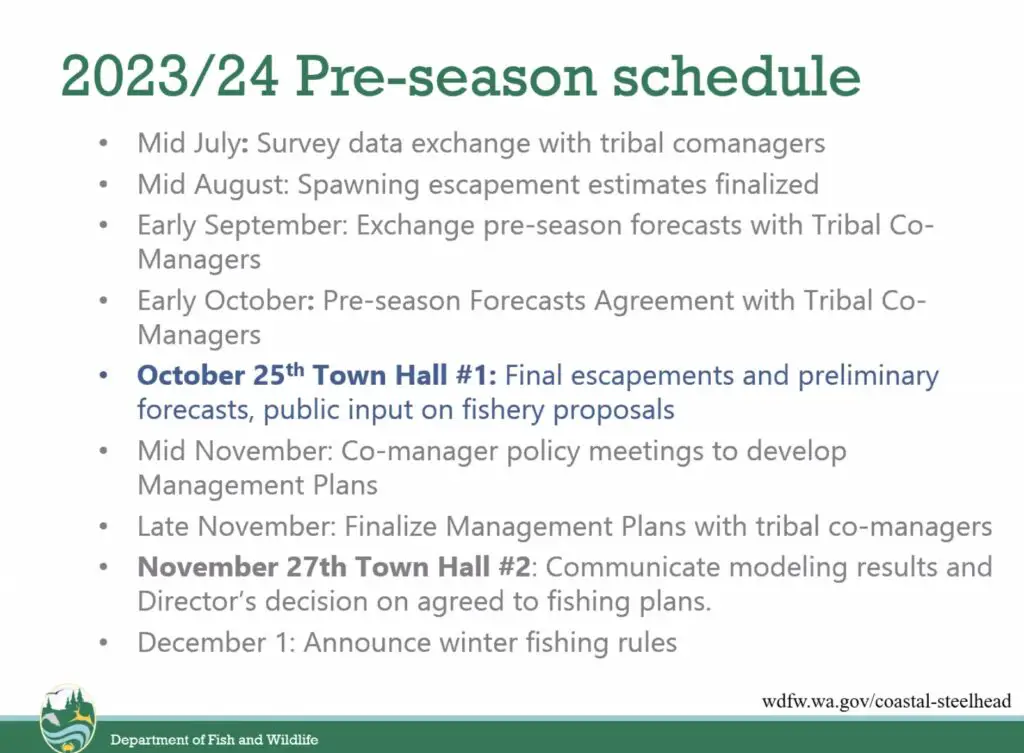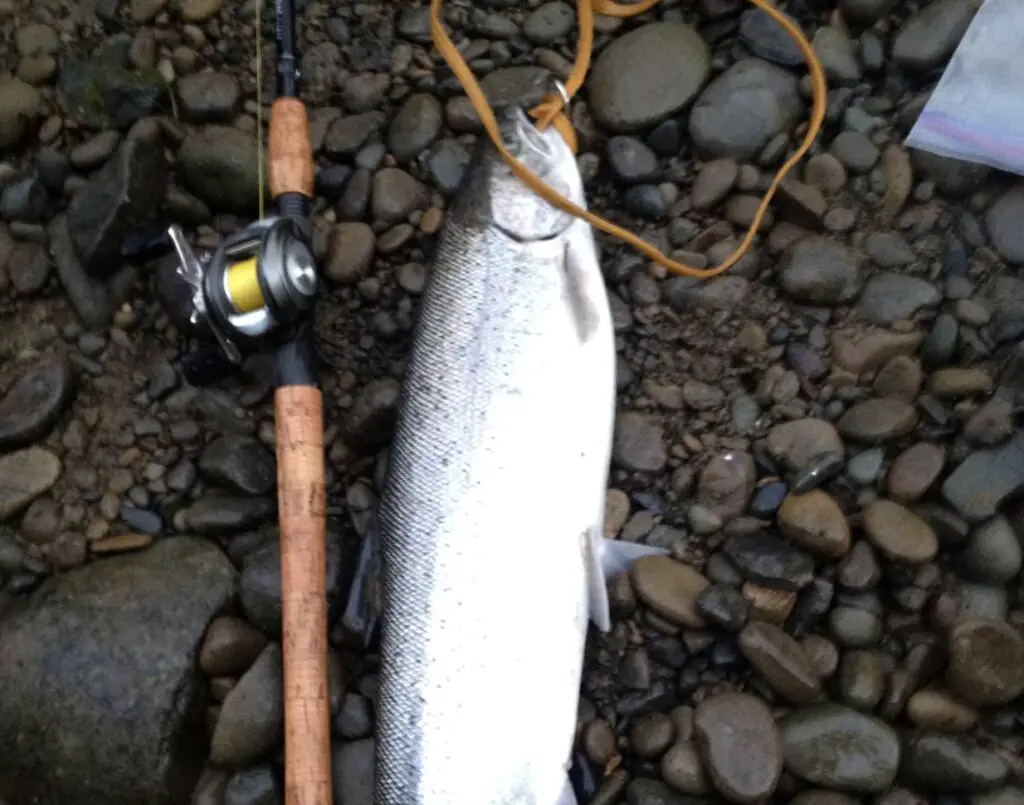
Last night was the first of several meetings that included the public, on the topic of the 2023-2024 winter steelhead season for the coastal rivers of Washington. In this blog post I will share what I learned and my overall impression of things.
The first hour of the meeting was basically just the department presenting all of the data associated with steelhead management and status on the coastal river systems. It was meant to bring everyone onto the same page, even those who’ve never attended a prior meeting.
“This is a steelhead. A steelhead is a type of fish. Oceans are warming. Steelhead numbers are down.”
Almost an hour into the meeting James Losee the coastal steelhead program manager stated “This is probably the slide most of you are here for”
Washington Coastal Steelhead 2023-2024 Preliminary Forecasts
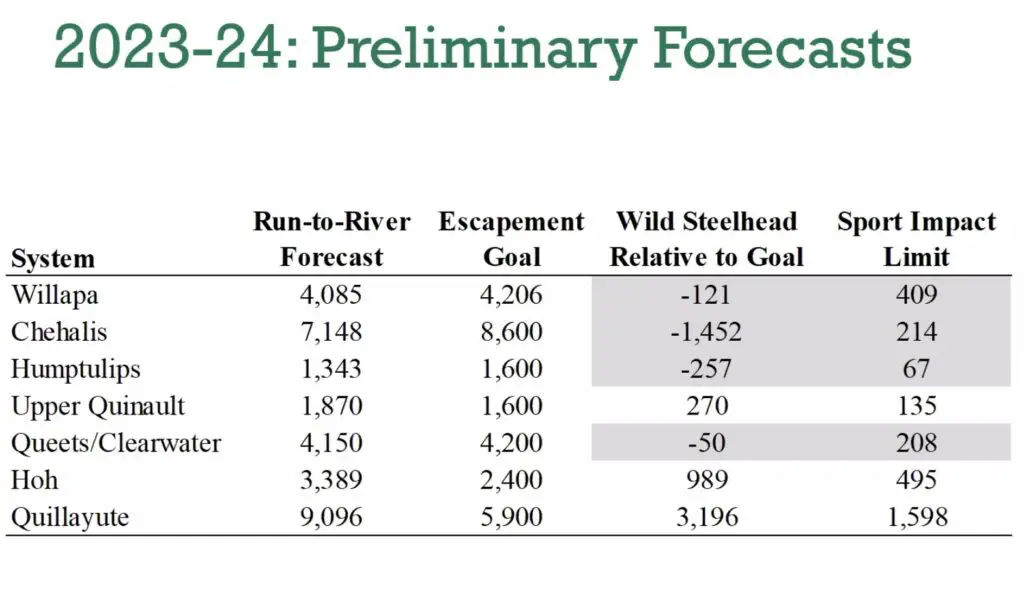
So there you have it, a similar picture as compared to previous years in terms of which river systems are potentially problematic and which ones look to be holding on to a healthy status.
But for review, here’s how the 2022-2023 season performed:
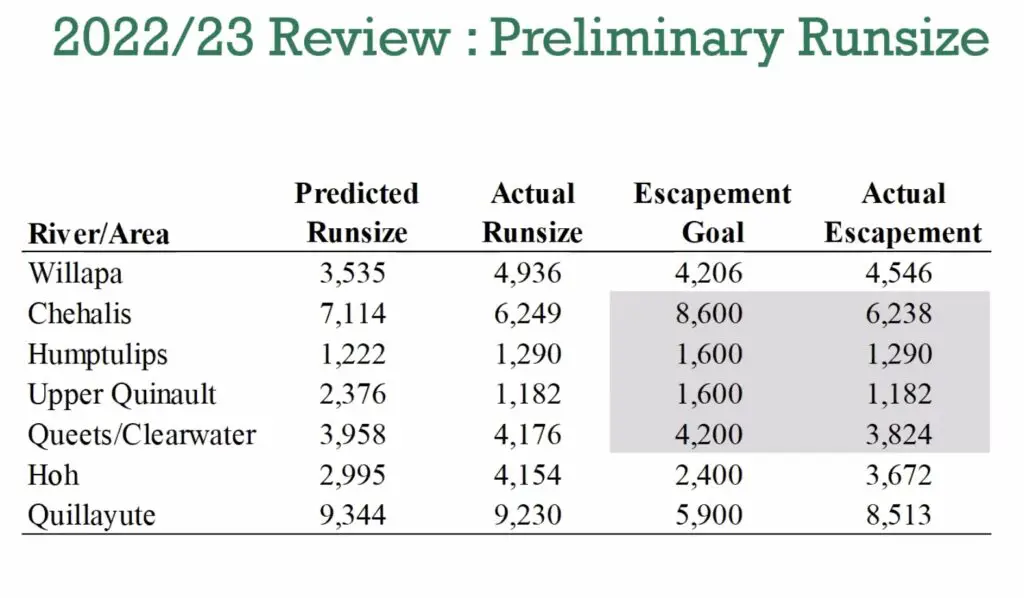
You might ask the obvious question here, which is how can we have a steelhead season on a run of steelhead expected to have a runsize below the escapement goal?
Well, the Statewide Steelhead Management Plan provides guidance that up to 10% impact on a given run is the allowable sport impact limit for these runs expected to miss the escapement goal.
This 10% provision is provided for two very important reasons:
- To allow salmon fisheries such as late coho into December to exist, as some steelhead will be encountered in that timeframe.
- Allow selective steelhead fisheries focussed on hatchery steelhead during the timeframe some wild steelhead may be encountered.
Washington coastal rivers expected to miss wild steelhead escapement goals
With all of the above considered we essentially have 4 river systems not expected to meet escapement for the 2023-2024 season.
- Chehalis
- Willapa
- Humptulips
- Queets / Clearwater
I’m going to assume that the Willapa Bay rivers will have a similar season structure compared to 2022-2023 as the numbers were quite good, above forecast and the escapement goal. The forecast for 2023-2024 is probably within error margins in terms of just missing the escapement goal.
The Queets / Clearwater situation has everything to do with the departments negotiation with the Quinault Indian Nation. Perhaps, we get to fish that system, or perhaps like last year we will have to hire a native guide.
It’s a bit of a sham, because the impact on the fish is largely the same, except we have to pay to fish.
I do understand the departments position of not wanting to endorse a fishery they believe will have a conservation concern, but to the general fishing public it won’t make much sense.
The Humptulips is likely going to be a scenario similar to the Chehalis, but potentially less likely to proceed due to the potential wild steelhead impact and difficulty to monitor. More on this below.
The big topic, that most of my fishy friends are interested in, is how to enable hatchery fisheries on Chehalis tributaries with good hatchery returns such as the Wynoochee and Skookumchuck. The Satsop has a hatchery return as well, but quite a bit fewer fish are expected.
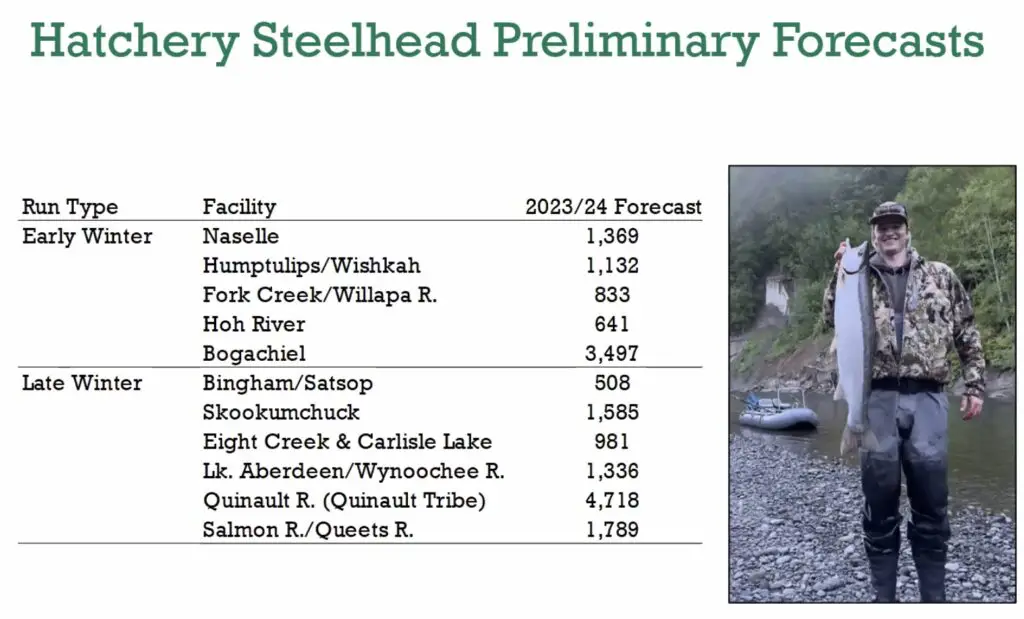
Will there be a Chehalis tributary fishery for hatchery steelhead in 2023-2024?
A significant goal of all this fishery management should be to maintain conservation factors for wild steelhead while enabling selective fisheries to target hatchery steelhead.
What I’ve been able to ascertain from this first meeting is that we don’t have a clear plan to get there yet (also that wasn’t the stated goal of the meeting), but the entire issue boils down to the departments ability to monitor a fishery and defend it to the co-managers as not having an impact above the allowable sport impact limits on wild steelhead.
Remember, that sport impact limit is 214 wild steelhead between all Chehalis fisheries, from December coho to any kind of steelhead fishery between December and April.
I brought up the point that, in particular the last mile of the Skookumchuck offers very low spawning habitat for wild steelhead, so if we enable fisheries near hatchery deadlines like the Skookumchuck, it creates a situation where expected impact is low, and it should be much easier to monitor with creel checking and test fishing.
This feedback was well received (just like last year).
I’ve heard optimism that something like this is in the works, but I gotta say, the vibe of the meeting last night felt identical to the one a year ago that eventually culminated with us not having a season on hatchery steelhead on the Chehalis river tributaries.
Optimism with caveats. Big caveats.
The reality is the department only has so much funds to spend on monitoring fisheries on the coast. And those funds last year were directed towards monitoring fisheries that were largely healthy vs trying to eek out seasons on unhealthy runs.
What has changed between last year and this year? We shall see….
Some meta thoughts about our coastal steelhead fishing situation and what you can do about it.
All of this has me wishing the general fishing public was a much better partner in all of this. That the level of hostility and mistrust between the public and WDFW didn’t exist to the level it does. Or that the general public could be relied upon to provide solid creel data and self-policing of conservation factors.
I know this stewardship dynamic does exist on certain streams, but these difficult environmental conditions aren’t going anywhere. From Puget Sound salmon to coastal steelhead, we are going to be in this hyper-vigilant mode for awhile.
Yes, you could take the tact of simply blaming the department, the environment, the tribe, the seals and sea-lions, or whatever. I don’t live my life as a victim though and prefer to take action which has a positive impact, however small that impact is vs wallowing in the blame game.
I started this blog in 2019 as a way to get more involved, to have a positive impact on the overall outcomes that enable this way of life: Fishing, hunting, harvesting food from the land and water in a sustainable way.
One of my primary goals continues to be how to answer the questions for the general public like the following: “What can I personally do to have net positive impact on the health of these runs of salmon and steelhead?” and “How can I ensure there’s fishing and harvest opportunity both now and in the future?”
I have a few thoughts about that question, but it starts with thinking differently about the entire pursuit of these fish. We are stewards of a resource, a very important resource, not just consumers of it.
I will try to avoid being long winded, but there are three things I think anyone of us can do that will have a positive outcome on steelhead conservation and enabling fisheries in the future:
First, stop spreading some of the popular myths about steelhead conservation. You know, the talk down on the gravel bar with lines like “There aint no wild steelhead anymore, that was just a mis-clipped hatchery fish.”
Yes, there are mis-clipped hatchery fish, and yes wild steelhead intermingle with hatchery fish, but these statements are often false, and the propagation of them leads to mis-handling of wild steelhead and in some cases illegal retention.
These run-sizes and forecasts literally determine our seasons, and they come from redd counts and outmigrations, both of which are directly impacted by wild steelhead which don’t make it to the spawning grounds, either because of release mortality or illegal retention.
Second, let’s commit to providing good creel data. Period. Not over-inflated creel data, the creel checker is not impressed with your big numbers nor thinks less of you for getting skunked. But, the bigger issue is honestly reporting encounter and release numbers. Yes, stating that you caught and released a wild steelhead may impact your season, but the general public being considered unreliable for scientific self-reported data is now a primary reason we don’t have a season at all. By the way that’s also true for Puget Sound…don’t get me started on that…
It’s time to think of ourselves as partners and stewards of the resource.
Lastly, buy a conservation net like the below and take it down to the river whenever fishing on a selective fishery. We should be appalled at the way some of our fellow anglers handle fish they intend to release. Enough already!
Sorry to get a bit preachy there. I’m passionate about this topic and want us all to be able to fish on healthy runs of steelhead both now and into the future.
Meeting schedule for 2023-2024 Washington Coastal Steelhead season setting.
